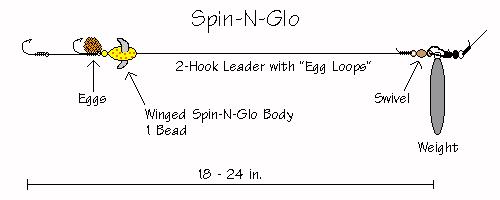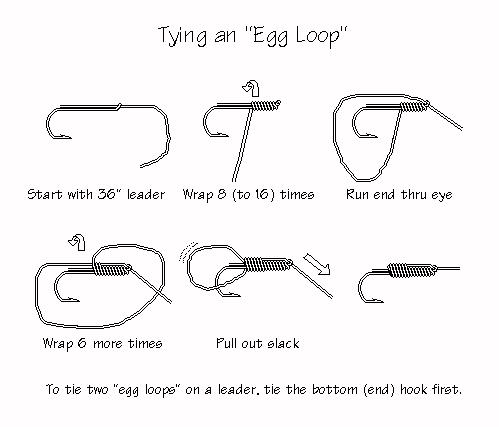How To Catch Alaska Salmon

The majority of questions I've gotten so far have to do with the type of
tackle commonly used to catch salmon. The "Spin-N-Glo" pictured above
is a preferred setup, where salmon roe (eggs) are allowed. The "Spin-N-Glo"
is a colored styrofoam body with two wings. This is slipped onto a
hooked leader. It should spin freely when placed in a moving stream
or river. A two-hook leader is normally used, tied with "egg loops"
to hold salmon roe.
Common theory is that salmon don't feed after entering fresh water, but they
do mouth salmon eggs, and then spit them out. (It may be that they
naturally want to spread out eggs they find floating in front of them.)
Also, being a predator fish, salmon will often bite at something
in front of them. The normal "bite" is often just a little tap or tug, and
not a big grab and run. Get used to the feeling of your weight bouncing
and dragging on the bottom, the feel of the current when your weight
comes to rest, and you'll be able to recognize when a salmon mouths your
hook.
The leaders can be bought in many department, grocery and sporting goods
stores, if you'd prefer not to make your own. Even if you buy the hooked
leaders, you'll need Spin-N-Glo bodies, beads, swivels, weights and the salmon
roe.
Once I have the hooked leader, I slide on a large bead and a Spin-N-Glo body.
Then I tie a swivel onto the loose end of the leader. The line
from the reel/rod has a snap swivel on the end, so I can easily attach the
Spin-N-Glo leader and a weight to the snap swivel. I can change
Spin-N-Glo's or weights without having to re-tie anything. I'll bring
5-6 Spin-N-Glo setups with me to fish. My preferred colors for the
Spin-N-Glo body are red or orange (with or without spots or stripes), yellow
with orange spots (or stripes), and a watermelon-looking arrangement, which
works well. Green is another often-used color.
Whatever type of sinkers you decide to use with a Spin-N-Glo, you'll need
a variety of weights: 1, 1.5, 2, and 2.5 ounces. The 1.5 and 2
ounce weights are what I end up using most often. I use a trolling
weight that's banana shaped with rings on either end -- sometimes they come
with a swivel on one end. I've seen people using ball or teardrop shaped
weights too. Still others use a 3-way swivel that has surgical tubing
slipped over the bottom swivel -- a length of tube-shaped weight, sold in
a roll, is cut to the proper length/weight and then slipped into the other
end of the tubing. Whatever type of weight you use, make sure
it's enough to stay on the bottom in what can often be fast-moving water.
If you're not at the bottom, you're not where the fish are.
As far as fishing line, I'd recommend 20 pound test as a minimum for salmon
unless you're experienced, and in an area where you can move freely downstream
after a hooked fish. I'd say that 25-30+ pound test is a better choice
for King salmon, which can also be used for silvers, chum, reds, etc. If
you want to use a lighter rig, bring a heavier backup. When fishing
for silvers, for example, I'll normally use a 12 pound setup, either
spinning or casting. But at the same time my wife uses 25 pound line, and she doesn't have to play the fish as much, or worry about the fish
taking off downstream in fast-moving water. In some areas, you can't
move around a lot, i.e., you can't chase a fish downstream as it takes all
your line, and a lot of the streams and rivers have very fast water, which
adds to need for a stronger rod and line. Make sure you have a rod
& reel combo that can handle the heaviest line you'll use.
I prefer an 8 to 8.5 foot rod, with a sensitive tip, in either medium or
med-heavy, for most salmon. A heavy action rod is a good idea for river
kings. If you're fishing from a boat, either on a river or in salt
water, you can often use a lighter rod and line. A seven foot
rod, like the two-piece Shakespeare medium action Big Water Ugly Stick, is acceptable for all salmon. The
8 foot version of this two-piece Big Water Ugly Stick is a good all-purpose
salmon rod too. If you want one rod for all salmon, I'd recommend either
of those. My
wife uses the medium-action seven foot Ugly Stick for all salmon. The
only time she's ever under-equipped is when a heavy king salmon heads off
downstream in fast water, but then again, it would take a telephone pole
and steel cable to bring back a fish in some cases. If you want the
heaviest, strongest King salmon rod, look at the one-piece 7-foot heavy action
Big Water Ugly Stick. (All the Shakespeare Big Water Ugly Stick rods
mentioned above are available at Bass Pro Shops, in the Salt Water Fishing Rod
section.)
The Ugly Stick will take
a lot of abuse. If you're buying an expensive graphite rod, make sure you're
not over-tightening the drag on the reel, and that you're not lifting your
rod handle past 12 o'clock -- straight up in the air. I've seen
more than a few people break their rods through mishandling, and then blame
the rod. A graphite rod will give you a better feel; but is more sensitive
to abuse, and doesn't have the strength of the Ugly Stick. I normally use
a Medium action 8.5' graphite rod for all salmon other than Kings.
In the debate of spinning vs. casting rod/reel combos, I'd say use whatever's
comfortable. It's true that a casting reel will give less line twist, but
if you're not comfortable with the drag or the balance of a casting rod &
reel, use a spinning rod. My favorite salmon combo, for everything other
than Kings, is an 8.5' spinning rod and reel combo that feels just perfect to
me; even though I have other spinning and casting rods available. Twisted
line will become weaker over time, but if you change your line at the start of
each fishing season, you shouldn't have problems with it. It's a good idea
to strip off 10 yards or so after a heavy fishing session. Cut it off and
retie. The end section of line takes a lot of abuse.



If you buy your leaders pre-tied, you don't need to know how to tie an egg
loop. I like to tie my own leaders, with a 25-30 pound leader, using
Gamakatsu hooks. But, I also bring along some backups that are store-bought
in packs of three. When I need a new Spin-N-Glo, I can just slide on
a new bead and Spin-N-Glo body, and then tie on a swivel. The bead
helps the Spin-N-Glo to spin easily. (Don't use tiny beads.)
A common mistake people make is the knot used to tie on their tackle. Any
knot, even the best, will be one of the weakest places in your line/tackle
setup. If you're not using a good knot, it will probably break when
you're max-performing your fishing gear on a big salmon. I like the
Uni-Knot, which is shown below.




